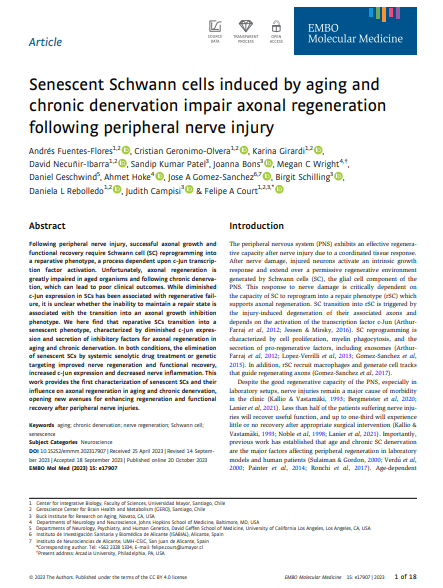Senescent Schwann cells induced by aging and chronic denervation impair axonal regeneration following peripheral nerve injury

Fecha
2023-12-07Autor
Geronimo-Olvera, Cristian [Center for Integrative Biology, Faculty of Sciences, Universidad Mayor, Chile]
Girardi, Karina [Center for Integrative Biology, Faculty of Sciences, Universidad Mayor, Chile]
Necuñir-Ibarra, David [Center for Integrative Biology, Faculty of Sciences, Universidad Mayor, Chile]
Kumar Patel, Sandip
Bons, Joanna
Wright, Megan C.
Geschwind, Daniel
Hoke, Ahmet
Gómez-Sánchez, José A.
Schilling, Birgit
Rebolledo, Daniela L. [Center for Integrative Biology, Faculty of Sciences, Universidad Mayor, Chile]
Campisi, Judith
Court, Felipe A. [Center for Integrative Biology, Faculty of Sciences, Universidad Mayor, Chile]
Ubicación geográfica
Notas
HERRAMIENTAS
Acceda a títulos restringidos
¿Cómo descargar?Resumen
Following peripheral nerve injury, successful axonal growth and functional recovery require Schwann cell (SC) reprogramming into a reparative phenotype, a process dependent upon c-Jun transcription factor activation. Unfortunately, axonal regeneration is greatly impaired in aged organisms and following chronic denervation, which can lead to poor clinical outcomes. While diminished c-Jun expression in SCs has been associated with regenerative failure, it is unclear whether the inability to maintain a repair state is associated with the transition into an axonal growth inhibition phenotype. We here find that reparative SCs transition into a senescent phenotype, characterized by diminished c-Jun expression and secretion of inhibitory factors for axonal regeneration in aging and chronic denervation. In both conditions, the elimination of senescent SCs by systemic senolytic drug treatment or genetic targeting improved nerve regeneration and functional recovery, increased c-Jun expression and decreased nerve inflammation. This work provides the first characterization of senescent SCs and their influence on axonal regeneration in aging and chronic denervation, opening new avenues for enhancing regeneration and functional recovery after peripheral nerve injuries.
URI
https://repositorio.umayor.cl/xmlui/handle/sibum/9455https://www.ncbi.nlm.nih.gov/pmc/articles/PMC10701627/pdf/EMMM-15-e17907.pdf
https://doi.org/10.15252/emmm.202317907
https://www.embopress.org/doi/full/10.15252/emmm.202317907
Coleccion/es a la/s que pertenece:
Si usted es autor(a) de este documento y NO desea que su publicación tenga acceso público en este repositorio, por favor complete el formulario aquí.
Ítems relacionados
Mostrando ítems relacionados por Título, autor o materia.
-
Adenomatoid Odontogenic Tumor Associated To Reactive Fibro Osseous Lesion: A Case Report
Jara, René [Oral Pathology, Dental School, Faculty of Medicine and Health Sciences, Mayor Univ, Chile]; Martínez, Paz [Oral Pathology, Dental School, Faculty of Medicine and Health Sciences, Mayor Univ, Chile]; Rees, Victoria [Oral Pathology, Dental School, Faculty of Medicine and Health Sciences, Mayor Univ, Chile]; Martínez, Benjamín [Oral Pathology, Dental School, Faculty of Medicine and Health Sciences, Mayor Univ, Chile]; González-Providell, Sergio [Oral Pathology, Dental School, Faculty of Medicine and Health Sciences, Mayor Univ, Chile] (Sociedad Española de Cirugía Bucal, 2023-08-01)An adenomatoid odontogenic tumor (AOT) is a benign epithelial lesion, being the fourth most common among all odontogenic tumors. Usually presents as slow painless growth that sometimes leads to facial asymmetry. Many cases ... -
Metformin protects from oxaliplatin induced peripheral neuropathy in rats
Martinez, N W [Center for Integrative Biology, Faculty of Sciences, Universidad Mayor, Chile]; Sánchez, A.; Diaz, P.; Broekhuizen, R.; Godoy, J.; Mondaca, S.; Catenaccio, A. [Center for Integrative Biology, Faculty of Sciences, Universidad Mayor, Chile]; Macanas, P.; Nervi, B.; Calvo, M.; Court, Felipe A. [Univ Mayor, Fac Sci, Ctr Integrat Biol, Chile] (Elsevier BV, 2020-08)Oxaliplatin is a commonly used drug to treat cancer, extending the rate of disease-free survival by 20% in colorectal cancer. However, oxaliplatin induces a disabling form of neuropathy resulting in more than 60% of patients ... -
Apical Sealing Efficacy of the Bioceramic Cements Bio Root and MTA Fillapex: An ex vivo Study
Aracena, Daniel [Dental School, Faculty of Sciences, Universidad Mayor, Chile]; Bustos, Luis; Aracena, Angella; Alvarez, Paula [Postgraduate Endodontic, Universidad Mayor, Chile]; Hernández-Vigueras, Scarlette (Universidad de La Frontera. Facultad de Medicina, 2021-06)The aim of this ex vivo study was to compare the ability of the apical sealing bioceramic cements BioRoot™ RCS (Septodont) and MTA-Fillapex (Angelus). One hundred and eighty-four vestibular canals were selected from ...